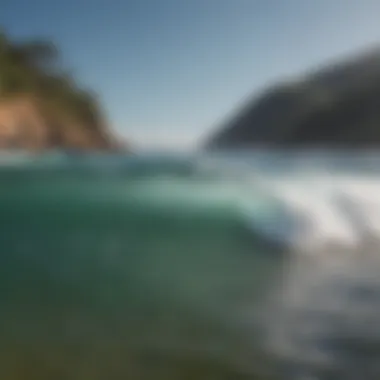Top East Coast Surfing Spots for Every Wave Rider


Intro
Surfing on the East Coast of the United States has its unique allure. It’s not just about catching waves; it’s about diving into a rich tapestry of culture, community, and coastline that traces back centuries. From New Jersey's sandy beaches to Florida's sun-kissed shores, the East Coast offers an array of surfing destinations, each with its own vibe, challenges, and rewards. This guide aims to peel back the layers and give surfers of all levels the insights they need to find their favorite surf spot.
Ample options exist, whether you seek mellow swells or gnarly barrels. Factors like local wind conditions, tide schedules, and even seasonal variations can significantly impact wave quality. Understanding these elements can mean the difference between a perfect day on the water and a frustrating session.
Beyond the surf itself lies the community—folks sharing waves, local surf shops offering gear and wisdom, and the vibrant culture that pulses wherever the ocean meets land. This article invites surfers, enthusiasts, travelers, and even casual beachgoers to engage with the fascinating world of East Coast surfing.
Surf Gear and Equipment
Surfing well is more than just jumping on a board and paddling out. The right gear makes a world of difference, whether you're riding the waves at Montauk or hanging ten in Virginia Beach.
Latest Surfboard Technologies
Modern surfboards have come a long way from their wooden predecessors. Nowadays, innovations like hydrofoils, epoxy materials, and advanced shaping techniques have revolutionized how boards perform in various conditions. For instance, surfboards crafted with engineered foam cores often result in lighter weights without sacrificing strength. These materials can enhance maneuverability and speed, allowing surfers to navigate tricky waters with ease.
For those looking to go even further, fin systems, such as Futures or FCS, give surfers the ability to customize their setup for varying wave conditions and personal styles. This adaptability can optimize a rider's experience and performance, reshaping standards on what can be accomplished on the water.
Essential Accessories for Surfers
Accessories don’t just complete your surf look; they improve performance and safety too. Here are a few must-haves:
- Leash: An essential safety item keeping you attached to your board when you wipe out.
- Wax: Helps grip your feet to the board. The type needed changes with water temperature.
- Rash Guard: Protects the skin from irritation and sunburn. Look for UV protection ratings.
- Change Mat: Useful for switching out of wetsuits without sandy feet.
These items might seem small, but they significantly impact your overall surf experience.
"The best surfer out there is the one having the most fun."
— Phil Edwards
Embarking on a surfing adventure without the right equipment is like going to battle without armor. Equip yourself appropriately, and you're halfway to achieving not just a ride but a memorable experience.
Techniques and Skills
The East Coast waves come with their own peculiarities, so honing the right techniques becomes essential in maximizing enjoyment and safety while surfing.
Wave Riding Strategies
Understanding wave dynamics is critical for surfers, from flat days to high-energy swells. Learning to read the ocean's rhythm can inform your choice of where to position yourself for the best rides. Beginners often find success in shifting from paddle-boarding to catching smaller waves as they build confidence.
Intermediate and advanced riders can experiment with different maneuvers like cutbacks, off-the-lip, and aerials, adapting their approach based on the wave size and type. Knowing when to paddle, when to pop up, and how to maintain balance on moving water is an art that takes practice.
Safety and Surf Etiquette
Every surfer should understand common surf etiquette before hitting the water. Key points include:
- Right of Way: The person closest to the peak of the wave has the right of way.
- Blocking Waves: Avoid dropping in on someone already riding; it’s both unsafe and discourteous.
- Respect: Treat locals and fellow surfers with kindness. Respect goes a long way in building community.
- Exit Safely: When finished riding, always exit the water clear of other surfers.
Learning these elements is crucial: not just to improve your skills but also to enjoy the session without causing accidents.
Finale
As you explore the East Coast’s premier surfing spots, remember both the gear and the techniques that can enhance your experience. With a little preparation and an awareness of the ocean’s moods, you can truly capture the essence of what it means to ride the waves.
Intro to East Coast Surfing
Surfing on the East Coast is a unique experience, with its own set of challenges and rewards. For many, the coast isn't just a playground; it's a way of life, woven into the cultural fabric of the region. From the windswept beaches of Maine to the warm shores of Florida, surfers find varied conditions and landscapes that cater to all skill levels. Understanding the ins and outs of this region is crucial for anyone keen on tackling its waves.
Geographical Overview
The East Coast stretches over 2,000 miles, encompassing a diverse array of geographical features. The northern reaches are marked by rocky shores and cooler waters, while the southern coasts flaunt golden sands and warm seas. Each area delivers its own conditions, making them suitable for different surfing styles.
- Maine and Massachusetts: here, surfers encounter challenging waves driven by the North Atlantic. The surf season is relatively short, but it’s primal and rewarding, with less crowding compared to the south.
- New York and New Jersey: known for iconic spots like Montauk and Asbury Park, these regions offer both swells and a lively scene. The mix of local surf culture and beautiful beaches makes it attractive for both new surfers and veterans.
- The Mid-Atlantic, including Delaware and Virginia: offers a blend of calm bays and powerful surf, producing waves suitable for all levels. Virginia Beach, with its consistent swells, is a popular destination.
- The Southeast, covering the Carolinas and Florida: presents some of the most beginner-friendly surf spots. The warm waters and consistent wind patterns often lead to good surf conditions year-round.
Historical Context
Surfing, as we know it, hit the East Coast long after its inception in Hawaii. The early 20th century saw a trickle of surfers arriving on these shores, but it wasn’t until the 1960s that the sport gained significant traction. With the rise of surf culture in California, the East Coast began to adopt and adapt similar styles and techniques.
In the 1960s and 70s, notable figures like Jack Murphy helped lay the groundwork for surfing communities up and down the coast. Local surf shops opened their doors, fostering communities of enthusiasts who engaged in competitions and social gatherings around the sport. The establishment of East Coast surfing competitions added to the growing culture, drawing in crowds and surf travelers looking for their piece of the wave.
Today, surfing on the East Coast reflects a rich blend of tradition and innovation. Local surfers are keenly aware of their influences, celebrating both classic styles and contemporary trends. This dichotomy plays a crucial role in shaping the identity of East Coast surfing.
"Surfing isn’t just riding waves; it's a culture, a community, and a connection to the ocean."
Whether you’re a novice eager to catch your first wave or an old hand looking for the next break, the journey of surfing on the East Coast is as alluring as it is multifaceted.
Top Surf Spots on the East Coast


The East Coast of the United States is a treasure trove of surfing spots that cater to various tastes and levels of expertise. From seasoned professionals seeking hefty waves to novices eager to catch their first ride, each location brings its own appeal. Understanding these spots allows surfers to make informed decisions based on the specific characteristics of each beach, enhancing their overall experience and surf session.
The Iconic Montauk
Montauk, perched at the eastern tip of Long Island, is often referred to as the Mecca of East Coast surfing. Its consistently solid waves and vibrant surf culture draw enthusiasts from all over. What sets Montauk apart is its unique geography; rugged yet beautiful coastlines create a variety of breaks suitable for different skill levels. One of the most well-known breaks, Ditch Plain, offers long, rolling waves that are perfect for both longboarders and shortboarders alike. The atmosphere here is imbued with a sense of community, where local surf shops like Surf Shack and Gordon’s not only provide gear but also foster a camaraderie among surfers.
The Vibrant Cape Hatteras
When talking about prime surf spots on the East Coast, Cape Hatteras is synonymous with adventure and natural beauty. Located in the Outer Banks of North Carolina, it is famous for its wind-swept beaches and undeniable surf charm. Hatteras gets a full range of wave conditions, making it a year-round playground. The shifting sandbars create incredible waves during certain times of the year, particularly in the fall when tropical storms stir things up. Plus, it’s often quieter than other surf spots, allowing surfers to enjoy the waves without overcrowding. For those who relish a laid-back setting while navigating through impressive swells, Cape Hatteras is a must-visit.
The Challenging Virginia Beach
Virginia Beach stands out not only due to its bustling boardwalk but also for the challenging surf it offers. Here, the waves can be quite fierce, especially during the hurricane season. Surfers often face steep drops and powerful waves, making it ideal for those looking to push their limits. The beach hosts various local surf competitions, creating an electric atmosphere filled with adrenaline. Engaging in a surf session here wouldn’t just test your skills; it also becomes a part of a community that thrives on the competitive spirit. Additionally, local spots like The Brewery provide a perfect post-surf hangout to exchange stories and tips.
The Family-Friendly Cocoa Beach
Cocoa Beach, often dubbed the ‘East Coast’s surfing capital,’ is a prime destination for families and beginner surfers alike. With its gentle waves and warm waters, it provides an ideal environment for those new to the sport. The surfing community here is inviting, offering lessons and rentals from spots like Cocoa Beach Surf Company. The area is also home to the World's Largest Surf Shop, a fun stop for families looking to gear up or simply browse. The laid-back vibe and family-friendly atmosphere make Cocoa Beach a favorite summer destination, ensuring families can relax while their kids learn to ride the waves.
The Remote Assateague Island
Assateague Island presents a unique opportunity for surfers seeking solitude and natural beauty. Located off the coast of Maryland and Virginia, this coastal paradise is not only known for its wild horses but also for its quiet surf spots. The waves here are less predictable but can be rewarding for those willing to explore. Surfers can enjoy uncrowded sessions while taking in the stunning views of untouched nature. Additionally, the need to respect the local wildlife and maintain the island's pristine environment resonates with many surfers. This destination is perfect for those who appreciate a bit of adventure with their surfing—it's worth noting to come prepared, as amenities are limited.
"Each surf spot carries its own unique stories and energetic vibes. Embrace the journey, as you are part of the rich tapestry of East Coast surfing."
The East Coast's surf culture is as diverse as its geography. Each destination offers distinct conditions and an atmosphere that contributes to the overall experience of surfing. While Montauk boasts consistent swells, Cape Hatteras provides versatility, Virginia Beach tests your skills, Cocoa Beach welcomes families, and Assateague Island offers tranquility.
These spots exemplify the rich tapestry of surfing along the East Coast, providing something for everyone. Such variations enrich the surfing experience, ensuring that every wave ridden is more than just an athletic achievement but also a step into a broader cultural experience.
Seasonal Surfing Conditions
Understanding the seasonal surfing conditions along the East Coast is crucial for anyone passionate about catching waves. Each season brings unique characteristics that can dictate the quality of surf, the size of waves, and the overall experience for surfers. Whether you're a seasoned pro or just starting out, knowing what to expect can make all the difference between an exhilarating session or a frustrating one.
Factors such as the prevailing winds, ocean temperatures, and storm patterns alter the surf environment significantly. Being aware of these shifts not only enhances performance but also ensures safety and enjoyment in the water.
Summer Swells
In summer, the East Coast usually sees mellow conditions that attract surfers of all levels. The sun shines high, and the ocean feels warm, making it perfect for long days on the shore.
Here are some key aspects of summer swells:
- Consistent Small Waves: Typically, summer brings smaller, more manageable waves. This is great for beginners looking to hone their skills without the intimidation of bigger surf.
- Hurricane Season: While summer is generally calm, the Atlantic hurricane season can spin up unexpected swells. When these storms roll in, surfers have a chance to ride some higher waves — though caution is paramount.
- Crowds: More surfers are out during the summer months, especially at popular spots like Cocoa Beach and Virginia Beach. Being aware of this can help you plan your trips wisely.
- Ideal for Longboard Use: The smaller, smoother waves in summer often cater well to longboarding, which allows for a more relaxed surfing style.
Summer surfing is about enjoying the beach vibe, the warm water, and perhaps catching the occasional fun set that rolls in.
Winter Waves
Winter on the East Coast is known for its harsher conditions, but it also presents unique opportunities for experienced surfers. Cold fronts sweep in, transforming surf spots into playgrounds of larger and more powerful waves.
Key considerations for winter waves include:
- Bigger Swells: The winter months can bring in some of the largest swells of the year. Locations like Montauk and Cape Hatteras can turn into serious surf havens during this period.
- Cold Water Wetsuits: Wetsuits become a necessity in freezing temperatures. A properly fitted wetsuit can make a world of difference, allowing surfers to stay warm and comfortable while capturing those epic rides.
- Less Crowded: Due to the cold weather, many casual surfers stay home. This means that more seasoned surfers can enjoy less crowded conditions towards the best waves.
- Watch the Forecast: Winter swells can be unpredictable, but keeping an eye on local surf reports will ensure that you're ready to hit the water when it’s at its best.
For those willing to brave the chill, winter offers some of the most rewarding surfing experiences.
Tropical Storm Season
Tropical storms can lead to some of the most intense surf conditions of the year. The wind generated by these storms can create powerful waves that attract both thrill-seekers and serious surfers. In these months, here's what to keep in mind:
- Unpredictable Swells: The waves during tropical storms can be incredibly large and erratic, presenting both an exciting and dangerous challenge. It’s best suited for those who are very comfortable in the water.
- Safety Precautions: Always check the forecasts and heed local advice. Surfing during a tropical storm can be risky due to rapidly changing conditions and strong currents.
- Short-Lived Opportunities: Often, the swell will only last for a few days, so being ready to paddle out at a moment’s notice is key.
- Variable Conditions: After the storm passes, it can also lead to unique wave formations; a day after a storm may produce clean, fun waves that are a joy to ride.
Tropical storm surfing demands respect and readiness, but it can be thrilling and rewarding for those who are up for it.
Remember, surfing is not just a sport; it's a lifestyle. Be prepared and enjoy every season waves can offer.
Environmental Considerations
As surfers, we are intimately connected to the ocean, where the rhythm of the waves captivates our souls and invigorates our spirits. However, with great pleasure comes great responsibility. Understanding Environmental Considerations in our surfing pursuits is not merely an afterthought; it is paramount in safeguarding the very playground where we seek out our bliss. This section sheds light on crucial elements surrounding ocean health and sustainable practices, urging surfers to embrace their role as custodians of the coastal environment.
Ocean Health Issues
One must acknowledge the pressing issues that plague our oceans. Pollution surfaces as a primary concern, manifesting through plastic debris, chemical runoff, and sewage discharge. Each year, millions of tons of plastic float into the sea, transforming our vibrant surf spots into bleak landscapes of waste. The oceans, home to countless marine species, face the repercussions of our negligence.
Coral reefs, for instance, are suffering immensely due to climate change and pollution. These structures, often referred to as the rainforests of the sea, not only provide habitat for diverse marine life but also act as natural barriers that protect shorelines from erosion. When surfers ride the waves formed by these ecosystems, they must acknowledge their fragility and regard how their actions affect these delicate structures.
Moreover, the overfishing crisis threatens the intricate balance of marine biodiversity. Surfers who enjoy the thrill of encounter with marine life can find themselves witnessing diminishing populations of fish and other sea animals.
"The health of our oceans is as crucial as the waves we ride; one impacts the other, directly and consistently."


Sustainable Surfing Practices
To counteract the negative effects on our oceans, surfers can adopt sustainable surfing practices. These practices are not merely trends; they encapsulate mindful behaviors and conscious choices aimed at preserving our beloved coastal ecosystems. Here are some suggestions:
- Choose Eco-Friendly Boards: Opt for surfboards made from sustainable materials, such as those created with renewable resources or recycled materials. Brands like Firewire Surfboards actively promote eco-friendly production processes.
- Participate in Beach Cleanups: Organizing or joining local cleanup events serves both community and environment. Collecting debris from shorelines not only improves surfing conditions but also reinforces a community of like-minded surf enthusiasts.
- Limit Waste: Adopt a "leave no trace" mentality. Be it through reducing single-use plastics or recycling your surf gear, even small gestures contribute to a larger change.
- Educate Fellow Surfers: Share information about sustainable practices within your surf community. Awareness fosters collective action, encouraging more surfers to embrace environmental stewardship.
- Supporting Organizations: Contributing to or volunteering for organizations focused on ocean conservation can facilitate impactful changes. Groups such as Surfrider Foundation provide surfers a platform to protect coastlines and oceans worldwide.
Ultimately, blending our passion for surfing with dedicated environmentalism enables us to enjoy ocean thrills while cherishing marine ecosystems. It’s not just a matter of catching the next wave but a call to action, urging surfers to foster a symbiotic relationship with the sea. By working together, we can preserve the paradise that beckons so many to its shores.
Surfing Culture on the East Coast
Surfing culture on the East Coast represents a vibrant tapestry interwoven with local tradition, community spirit, and a love for the ocean. This culture is not just about riding waves; it's about embracing a lifestyle that values connection, both with the sea and each other. It highlights the unique nuances of each region, influenced by the geography and demographics of the coastal cities and towns.
Community and Lifestyle
The essence of surfing culture is heavily rooted in community engagement and lifestyle choices. Whether participating in local contests, joining clubs, or enjoying seasonal celebrations, these activities forge connections among surfers, fostering camaraderie and shared experiences.
Local Surf Competitions
Local surf competitions play a significant role in enhancing the surf culture. These events draw in both seasoned pros and eager novices, creating a competitive yet supportive atmosphere.
One key characteristic of these competitions is their accessibility; they often welcome all skill levels, encouraging newcomers to test their mettle alongside experienced surfers. The thrill of competing fosters a sense of achievement and motivates surfers to hone their skills.
However, while these competitions can elevate one's surfing game, they can also lead to a bit of pressure. Participants might focus more on winning rather than enjoying the ride, which can dull the spirit of camaraderie and fun that underpins local surf culture.
Surf Clubs and Groups
Surf clubs and groups serve as another cornerstone of East Coast surfing culture. These organizations often unite surfers from various backgrounds, creating opportunities for mentorship and skill development. Regular meet-ups and group sessions promote teamwork and allow surfers to learn from one another in a relaxed environment.
A hallmark characteristic of these clubs is their local focus. Many clubs are dedicated to clean ocean practices and environmental sustainability, emphasizing the importance of protecting the coastlines.
Nonetheless, involvement in a surf club has its challenges. The commitment required can be daunting for new surfers, and the varying skill levels may lead to frustration if competitive nature overshadows the joy of surfing.
Surfing Festivals
Surfing festivals are another vibrant aspect of the East Coast surf scene. These festivals often feature live music, art, and surfing demos, becoming a celebration of coastal culture. They entertain but also educate the public on beach safety and environmental awareness, making it a holistic experience for attendees.
The festivals' inclusive nature makes them a popular choice among surfers and non-surfers alike. They serve as a melting pot of different cultures, showcasing the artistry of surfboard craftsmanship, local food, and music, blending to create an unforgettable community event.
However, the bustling nature of such festivals can be overwhelming for some, potentially overshadowing the close-knit aspects of local surf culture. The challenge lies in balancing festival activities with the core values of surfing and community.
Influential Surf Figures
Within the framework of East Coast surfing culture, influential figures emerge as guiding lights, shaping trends and practices over the years. From local legends to modern innovators, these individuals inspire new generations of surfers through their commitment, skills, and community involvement. Their stories contribute significantly to the cultural identity of this unique surfing enclave, making the East Coast's surf culture a dynamic and ever-evolving entity.
Choosing the Right Gear for East Coast Surfing
When it comes to surfing on the East Coast, choosing the right gear can make or break your experience. The surf conditions vary significantly from one spot to another, influenced by factors like weather patterns, water temperature, and wave height. A well-equipped surfer is not just safer but also able to enjoy the thrill of the waves more fully. Whether you're paddling out at Montauk or catching waves in Cape Hatteras, the gear you choose ought to reflect the conditions you'll face.
Surfboards Best Suited for Local Conditions
Each East Coast surf spot has its own distinct characteristics, and your choice of surfboard plays a crucial role in how well you can perform. Here are some considerations:
- Shortboards are ideal for places with steeper waves and fast conditions, like the beaches of New Jersey and New York. Their design enables quick turns and fast rides.
- Longboards, on the other hand, are great for catching smaller, slower waves, making them a better fit for areas like Cocoa Beach where more relaxed rides are common.
- Fish boards can be versatile, especially in softer waves often found on the Outer Banks. They offer buoyancy and stability while still allowing for maneuvers when the conditions are right.
The key is to assess the typical surf conditions of each location you plan to visit. Factors like expected size of waves and your own skill level should guide your choice.
Wetsuits and Apparel Considerations
Getting wet is part of the game, but staying warm and comfortable while doing it might require some thought into your apparel.
- Wetsuit thickness varies with the season. Generally, a 3/2 mm suit will suffice for summer months, while a 4/3 mm or thicker is often necessary for winter surfing.
- Spring suits or shorties also serve well during transitional seasons where water temps are on the rise or fall.
- Don’t overlook accessories! Booties might be a game changer in winter, as they keep your feet warm when you’re paddling out in chillier conditions.
More than just warmth, choosing the right rash guard or surf shirt can protect against sunburns and rashes caused by board contact. So, think about how you kit yourself out entirely.
In essence: investing in the right surfboards and wetsuits is more than a logistical choice; it’s about enhancing your enjoyment, ensuring safety, and allowing for a deeper connection with the waves and the community that surrounds them.
Tips for Novice Surfers
Diving into the world of surfing can feel like jumping into the deep end without a life jacket. Yet, for novice surfers, cultivating the right skills and understanding basic guidelines are foundational. This section will navigate essential competencies and safety protocols to help new surfers not only to stay afloat but also enjoy their time on the waves. Whether you're a casual beachgoer or someone considering taking up surfing as a hobby, these tips are crucial.
Essential Skills and Techniques
Mastering the art of surfing starts with a few basic techniques. Among the most important skills you need to develop are paddling, popping up, and balance. Here's a closer look:
- Paddling: This is your mode of transportation to catch waves. The proper technique requires you to lie prone on the board, using your arms to paddle while keeping your body streamlined. Think of it like a swimming stroke but on a surfboard. Remember to look ahead, and you'll maintain your momentum.
- Popping Up: Once you feel a wave lift you, it's crucial to pop up quickly yet fluidly. You want to go from lying down to standing in one smooth motion. A recommended approach is to place your back foot near the tail of the board, followed by your front foot. Practice this maneuver on a flat surface before attempting it in the water.
- Balance: Standing on the board requires practice and stability. Engage your core muscles, and keep your knees bent to maintain an agile stance. A good drill is to practice riding on your feet in shallow water, starting with just the white foam of a wave.


Safety Guidelines
Surfing brings about its own set of risks and challenges, meaning understanding safety is paramount. To navigate the waves safely, consider the following guidelines:
- Know Your Limits: Don't venture into conditions beyond your skill level. Each wave can present a different challenge, so gauge the surf before paddling out.
- Wear Safety Gear: While wetsuits may be optional in warm weather, wearing a surf leash and booties can protect your feet and keep your board close to you after a wipeout.
- Understand Surf Etiquette: Respecting the rules of the lineup is essential. Communicate with fellow surfers, and avoid dropping in on someone already riding the wave. Be patient—your turn will come.
- Stay Aware of Your Surroundings: Keep an eye out for currents, rocks, and other surfers. If you're near the shoreline, be extra cautious about people swimming.
- Know When to Get Out: If conditions worsen or you're feeling exhausted, it’s best to exit the water. Don't be a hero—your safety should always come first.
"Respect the ocean; it can be your playground but also your fiercest teacher."
By honing these fundamental skills and adhering to these safety principles, novice surfers can enhance their experience on the water. Learning to ride the waves should be an invigorating journey rather than a daunting task. With each session, confidence grows, as does the enjoyment that comes from carving through the waters of the East Coast.
Advanced Techniques for Experienced Surfers
Experienced surfers often navigate their craft with a level of finesse that separates them from novice counterparts. Mastering advanced techniques is not merely for show; they are critical in enhancing performance, safety, and overall enjoyment on the water. Knowing when to apply such techniques can be the difference between a good ride and an exhilarating session.
Wave Selection and Reading Conditions
Selecting the right wave is as paramount as any skill in surfing. Understanding the nuances of wave patterns helps surfers better position themselves for the optimal ride. Conditions can change rapidly; thus, being adept at reading the ocean is fundamental.
Here are key considerations that can sharpen your wave selection:
- Observe Wind Direction: Wind can drastically affect wave quality. Offshore winds hold the waves up and create cleaner faces, while onshore winds can create choppy, messy conditions.
- Tidal Effects: Knowledge of how tides affect your surf spot is essential. For instance, some waves work wonders on mid-tide, but become non-existent during low tide.
- Rip Currents: Experienced surfers should be able to identify rip currents that can aid them in getting out past the breaking waves. While these currents should be approached with caution, they can also be utilized to line up perfectly with incoming sets.
While it might seem forms of art, reading conditions is a skill honed through practice, observation, and experience in diverse waves.
"The beach is my canvas, the waves my paint; each session a new masterpiece awaiting my brush."
Performance Enhancement Strategies
Once your wave selection is sharp, the next step is enhancing performance. This means pushing your skills to the next level through specific strategies that can help surf in more challenging conditions and improve overall riding techniques.
Here are approaches to consider:
- Analysis of Surf Technique: Record your sessions and analyze your style. It’s often helpful to see one’s own movements from a different perspective. Small adjustments in posture or weight distribution can yield significant results.
- Dynamic Stretching and Cross-Training: Keeping your body in top physical condition can’t be overstated. Engaging in activities like yoga, swimming, or skateboarding can improve balance, flexibility, and core strength, all essential for maneuverability on a board.
- Familiarization with Different Boards: Experimenting with various surfboards allows you to find the one that suits your level and the type of wave you’re tackling. Shortboards may be ideal for aggressive maneuvers, while longboards can offer stability and smooth rides.
- Focus on Specific Manuevers: Spend time honing particular techniques such as cutbacks, bottom turns, or airs. Set aside practice sessions with a focus on one maneuver at a time, making small adjustments until mastery is achieved.
As each experienced surfer has unique strengths and weaknesses, tailoring approaches to individual needs is vital for significant improvements. The ocean is a vast mentor, but surfing growth starts on land, in thoughtful practice and self-reflection.
Travel Insights for Surf Enthusiasts
When it comes to surfing on the East Coast, understanding the nitty-gritty of travel logistics can make or break your experience. Surfing isn't just about the thrill of riding the waves; it's also about knowing where to stay, how to get around, and how to fully immerse yourself in the local scene. Travelers who dive into these details will not only save themselves a heap of hassle but also enhance their overall surfing adventure.
Proper planning allows surfers to focus on what really matters—the surf. Think about it: wouldn’t you rather spend your time catching the perfect wave than stressing over where to crash after a long day in the water? Plus, understanding the travel landscape helps in finding spots where the local surfing culture thrives, enabling a richer experience.
Navigating Local Accommodation Options
Finding a place to lay your head after a demanding day in the water is crucial. Surfers often have unique needs when it comes to accommodations—proximity to surf spots, budget considerations, and flexible booking options are just a few of these. Here are some key types of lodging to consider:
- Surf Camps: These spots offer packages that include meals, surfing lessons, and accommodation. Plus, they tend to foster a community of like-minded surf enthusiasts.
- Beachfront Rentals: For those who want the sea at their doorstep, renting a beach house can be ideal. It gives the convenience of quick access to the waves while also offering a comfy retreat.
- Hostels and Budget Hotels: Perfect for travelers looking to save a few bucks. These often accommodate other surfers, creating a lively atmosphere.
It’s important to check online reviews and look into amenities. Services like laundry facilities or outdoor showers can make a big difference, especially after a long day of riding the waves.
Transport Considerations Near Surf Spots
Getting around can vary widely depending on where you’re surfing. Consider the following aspects:
- Rental Cars: This is often the best option for surfers looking to explore various spots up and down the coast at their own pace.
- Public Transit: Some coastal towns have decent public transport systems, but they might not always align with surf schedules. Check local transit maps to see what’s feasible.
- Bike Rentals: Several beach towns are bike-friendly. Renting a bike can be not only a fun way to get around but also provides a unique view of the surroundings.
A good rule of thumb is to choose accommodation that minimizes the distance to your preferred surf spots. This can help give you more time in the water and less time fumbling about trying to figure out local transport.
"Knowing the ins and outs of where to stay and how to navigate the area can significantly boost your surfing experience.\nLook at every detail, and keep it smooth sailing!"
Ending
In this final section, we synthesize the rich tapestry of information woven throughout the article. Surfing on the East Coast isn't just about riding the waves; it’s about embracing a lifestyle marked by community, environmental awareness, and personal growth. The richness of the surf culture here offers something for everyone, from those just dipping their toes in to seasoned veterans slicing through the surf.
Recap of Key Insights
To summarize the key points discussed:
- Diverse Surfing Environments: From the tranquil shores of Cocoa Beach to the rugged waves of Montauk, each destination boasts unique characteristics influenced by geography and seasonal changes.
- Cultural Significance: The sense of community among surfers is palpable, fostered through local clubs, competitions, and festivals. This culture not only enhances the experience but also cultivates a robust support system.
- Environmental Awareness: As the waves beckon surfers, it’s imperative to recognize the environmental impact of our sport and embrace sustainable practices. This wasn't just a warning but a call to cultivate awareness and action towards the health of our oceans.
- Practical Tips for All Levels: The article provides essential advice, from the best gear suited for local conditions to safety measures for uncrowded waters.
Each of these insights contributes significantly to understanding the East Coast's surfing landscape, underlining its allure and challenges.
Encouragement for Continued Exploration
While this article has mapped out many essential elements of East Coast surfing, the journey doesn’t need to end here. We encourage surfers, enthusiasts, and adventurers alike to continually explore the coast—both literally and metaphorically. There are always new waves to catch and fresh spots to discover, maybe even a hidden gem known only to locals.
Venturing beyond well-known sites might reward you with serene settings and uncrowded waves, while deeper insights into the culture and history enrich your surfing travels. Furthermore, applying the principles of sustainable surfing not only helps preserve surf spots but also enhances your own experience.
So grab your board, check the waves, and let the adventure continue. Surfing is more than just a sport; it's a lifestyle, an experience that beckons us to ride the waves, embrace new discoveries, and deepen our connection with the ocean. Whether you're a local or a traveler, the East Coast has secrets yet to unfold, just waiting to be danced on by eager surfers.
"The ocean stirs the heart, inspires the imagination, and brings eternal joy to the soul."
Embrace it, challenge it, and never stop exploring.















